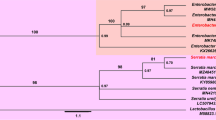Abstract
Microplitis croceipes (Hymenoptera: Braconidae) is a larval parasitoid of Helicoverpa/Heliothis spp. In the course of mass rearing of M. croceipes, we found that females oviposited in the conspecific adults in rearing cages. When 20 pairs of inexperienced females and males or of experienced females and males were reared in a cage, the males lived for 14–15 days and the females for 18–20 days on average. At their death, 37–42% of the males and 50–57% of the females contained conspecific eggs or first instar larvae in their abdominal cavity. When two of inexperienced females met on a host-infested leaf of soybean, they attempted to sting each other. Of the attacked females, 30% contained a conspecific egg laid in their abdomen. In abdominal cavity of the adults parasitized by a conspecific female, the majority of the parasitoid eggs laid disappeared within 1 day after oviposition. Only 10–30% of the parasitoid eggs laid in conspecific adults hatched 3–4 days after oviposition, but those larvae never molted to second instar. When the adults were stung by one or two conspecific females, their subsequent longevity was significantly shorter than that for the control adults. Oviposition in conspecific adults may be prevalent in other parasitic wasps that quickly oviposit without intensive host examination, and have cuticle and size of abdomen to be stung by conspeicifcs.
Similar content being viewed by others
References
Blumberg D, Ferkovich SM (1994) Development and encapsulation of the endoparasitoid, Microplitis croceipes (Hymenoptera: Braconidae), in six candidate host species. Entomophaga 39:293–302
Ferkovich SM, Gupta P (1998) Interaction of calyx fluid and venom from Microplitis croceipes (Braconidae) on developmental disruption of the natural host, Helicoverpa zea, and two atypical hosts, Galleria mellonella and Spodoptera exigua. J Insect Physiol 44:713–719
Ferkovich SM, Dillard C, Oberlander H (2005) Stimulation of embryonic development in Microplitis croceipes (Braconidae) in cell culture media preconditioned with a fat body cell line derived from a nonpermissive host, gypsy moth, Lymantria dispar. Arch Insect Biochem Physiol 18:169–175
Gauld I, Bolton B (1988) The hymenoptera. Oxford University Press, New York
Gupta P, Sloan A, Dillard CR, Ferkovich M (1996) Parasitism of a factitious host, Galleria mellonella (Lepidoptera: Pyralidae) by an endoparasitoid: oviposition and emergence of Microplitis croceipes (Hymenoptera: Braconidae). Florida Entomologist 79:221–229
Herman TJB, Davidson MM (2000) Introduction and establishment of Microplitis croceipes, a larval parasitoid of Heliothis, in North Island pine forests. New Zealand Plant Protection 53:328–333
Le KH, Takasu K (2005) Helicoverpa armigera as an alternative host of the larval parasitoid Microplitis croceipes (Hymenoptera: Braconidae). Appl Entomol Zool 40:679–686
Lewis WJ, Burton RI (1970) Rearing Microplitis croceipes in the laboratory with Heliothis zea as hosts. J Econ Entomol 61:673–676
Lewis WJ, Martin WR Jr (1990) Semiochemicals for use with parasitoids: status and future. J Chem Ecol 16:3067–3089
Lewis WJ, Snow JW (1971) Fecundity, sex ratios, and egg distribution by Microplitis croceipes, a parasite of Heliothis. J Econ Entomol 64:6–8
Lewis WJ, Tumlinson JH (1988) Host detection by chemically mediated associative learning in a parasitic wasp. Nature 331:257–259
Meiners T, Wäckers F, Lewis WJ (2003) Associative learning of complex odours in parasitoid host location. Chem Senses 28:231–236
Navasero R, Elzen G (1992) Influence of maternal age and host deprivation on egg production and parasitization by Microplitis croceipes (Hym.: Braconidae). Entomophaga 37:37–44
Olson DM, Rains GC, Meiners T, Takasu K, Tertuliano M, Tumlinson JH, Wäckers FL, Lewis WJ (2003) Parasitic wasps learn and report diverse chemicals with unique conditionable behaviors. Chem Senses 28:545–549
Quicke DL (1997) Parasitic wasps. Chapman & Hall, London
Roberts HLS, Schmidt O (2004) Lifetime egg maturation by host-derived Venturia canescens. J Insect Behav 50:195–202
Rojas MG, Morales-Ramos JA, King EG, Saldana G, Greenberg SM (1998) Use of a factitious host and supplemented adult diet to rear and induce oogenesis in Catolaccus grandis (Hymenoptera: Pteromalidae). Environ Entomol 27:499–507
Salt G (1935) Experimental studies in insect parasitism. III. Host selection. Proc R Soc Lond 117:413–435
Schmidt JM (1994) Host recognition and acceptance by Trichogramma. In: Wajinberg E, Hassan SA (eds) Biological control with egg parasitoids. CAB, Wallingford UK, pp 165–200
Takasu K, Lewis WJ (2003) Learning of host searching cues by the larval parasitoid Microplitis croceipes. Entomol Exp Appl 108:77–86
Takasu K, Overholt WA (1997) Aggressive behaviour of Chilo partellus (Swinhoe) larvae against the parasitoid, Cotesia flavipes Cameron. Insect Sci Appl 17:131–135
Takasu K, Overholt WA (1998) Brood guarding behavior and life history characteristics of Goniozus indicus Ashmead (Hymenoptera: Bethylidae), a larval ectoparasitoid of lepidopteran stemborers. Appl Entomol Zool 33:121–126
Takasu K, Takano S, Sasaki M, Yagi S, Nakamura S (2003) Host recognition by the tick parasitoid Ixodiphagus hookeri (Hymenoptera: Encyrtidae). Environ Entomol 32:614–617
Tilden RL, Ferkovich SM (1988) Kairomonal stimulation of oviposition into an artificial substrate by the endoparasitoid Microplitis croceipes (Hymenoptera: Braconidae). Ann Entomol Soc Am 81:152–15
van Alphen JJM, Jervis MA (1996) Foraging behavior. In: Jervis M, Kidd N (eds) Insect natural enemies, practical approaches to their study and evaluation. Chapman & Hall, London UK, pp 1–62
Acknowledgement
We thank Michael R. Strand for valuable comments on an earlier draft. This work was supported partly by User Science Institute in Kyushu University (Special Coordination Funds for Promoting Science and Technology) and Kyushu University Foundation.
Author information
Authors and Affiliations
Corresponding author
Rights and permissions
About this article
Cite this article
Takasu, K., Hoang Le, K. The larval parasitoid Microplitis croceipes oviposits in conspecific adults. Naturwissenschaften 94, 200–206 (2007). https://doi.org/10.1007/s00114-006-0181-3
Received:
Revised:
Accepted:
Published:
Issue Date:
DOI: https://doi.org/10.1007/s00114-006-0181-3




